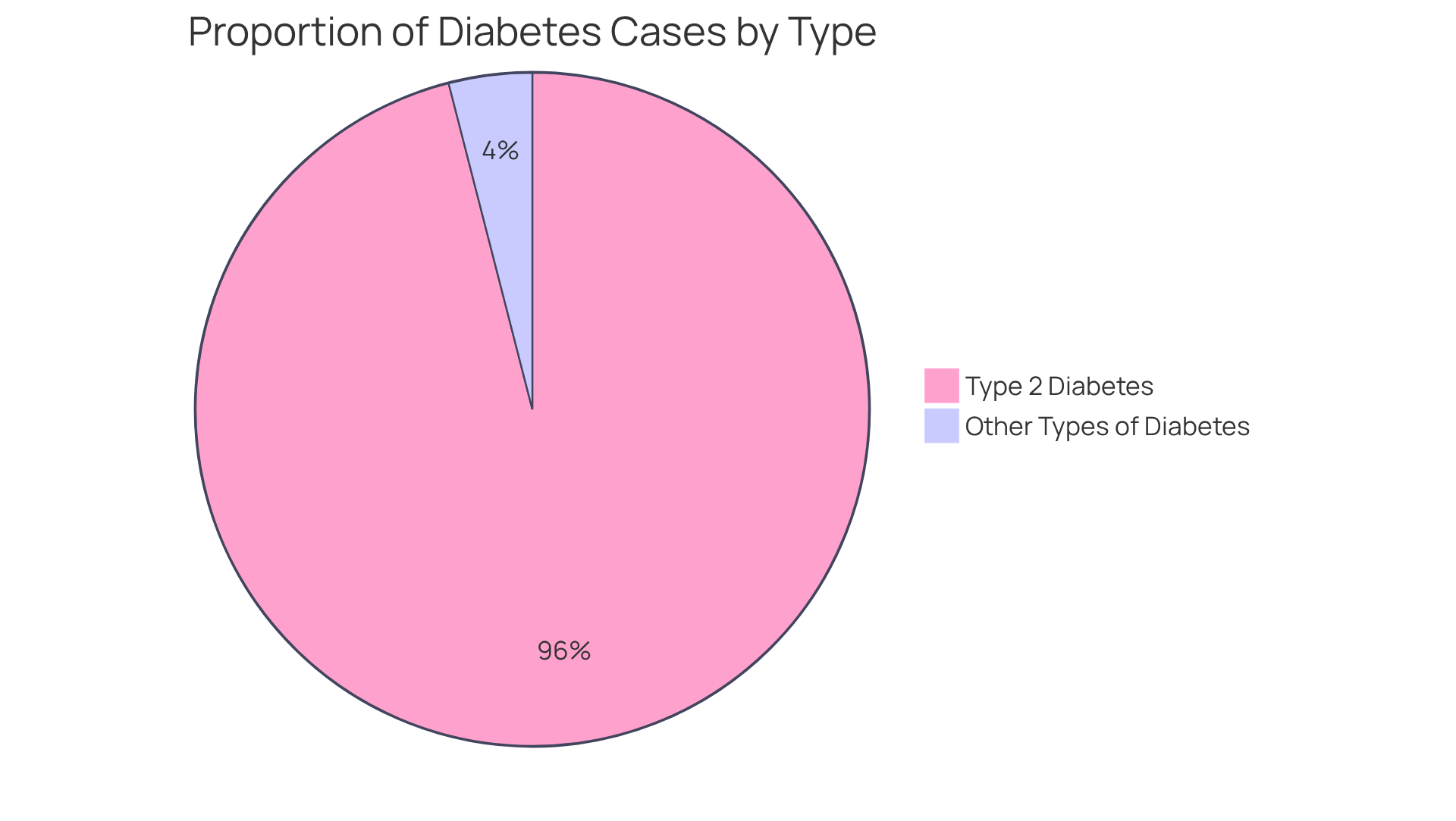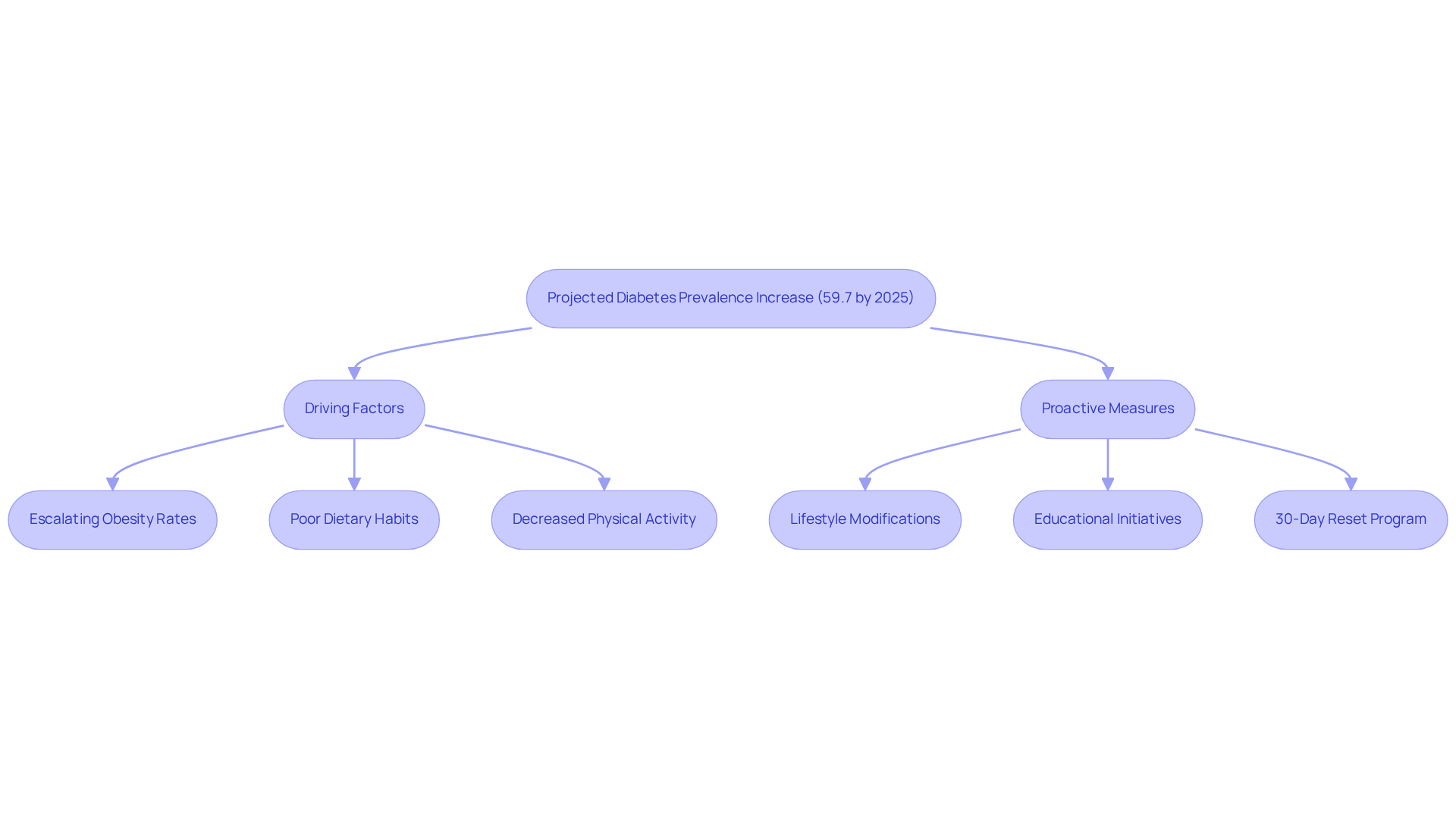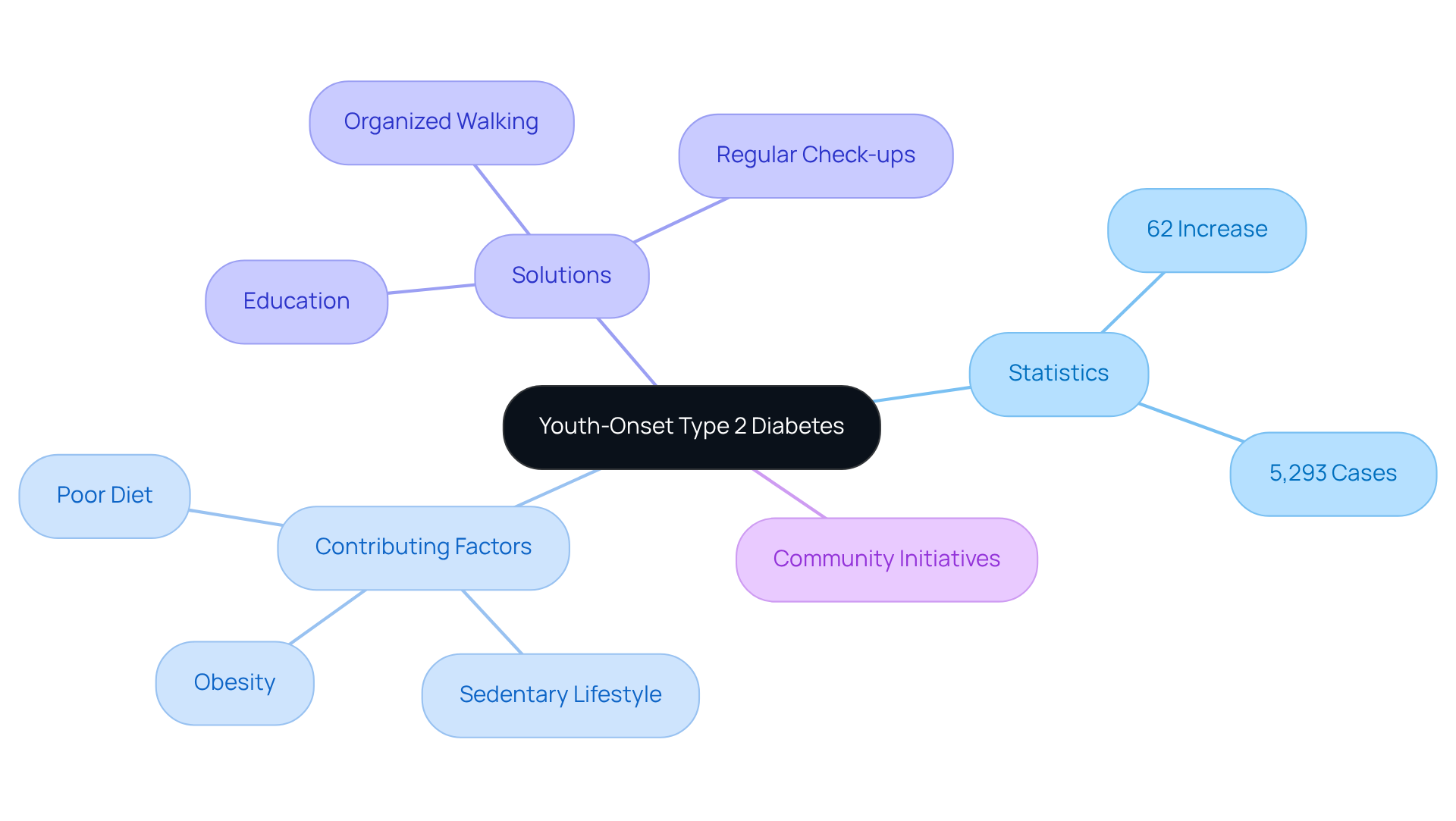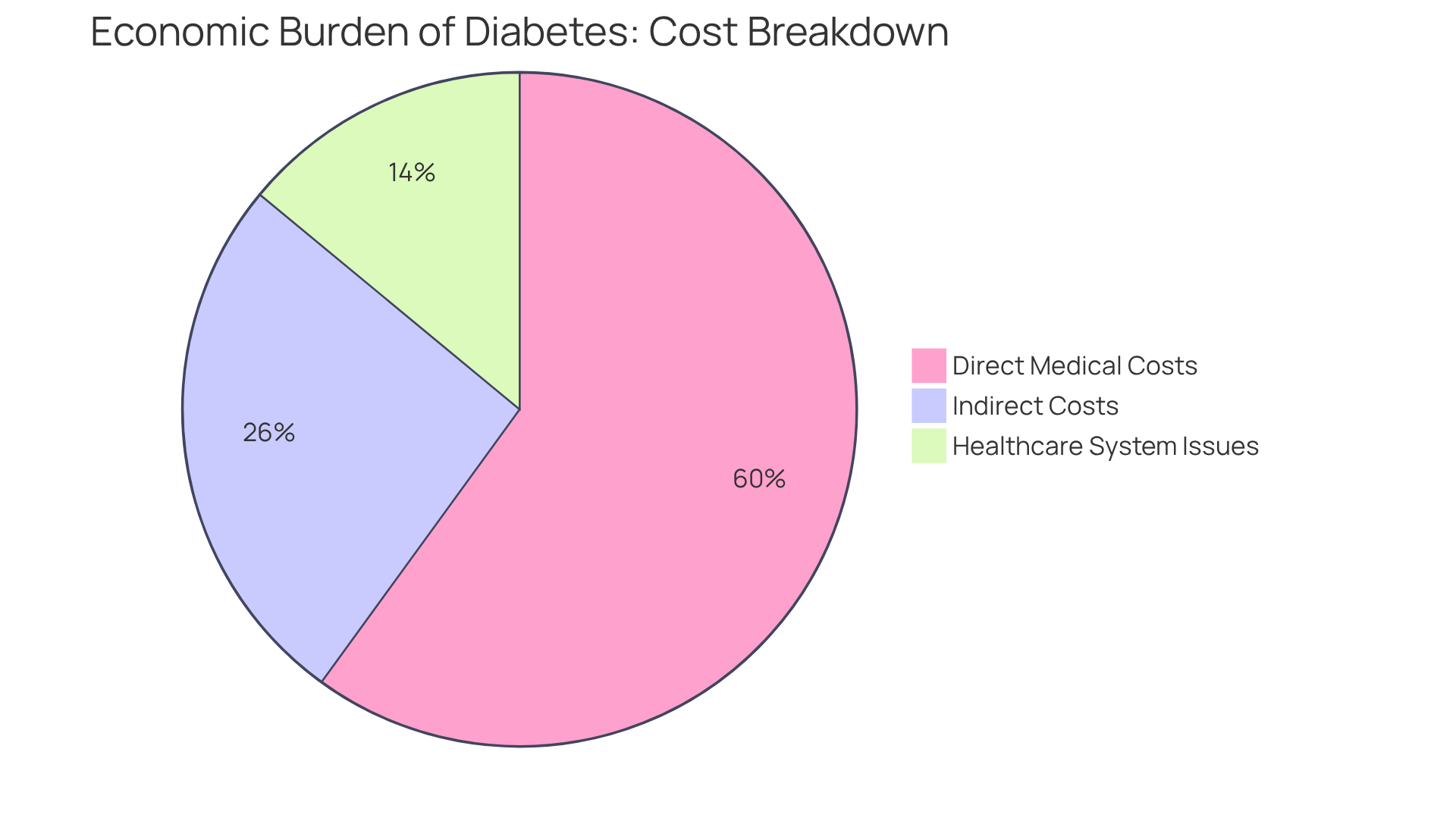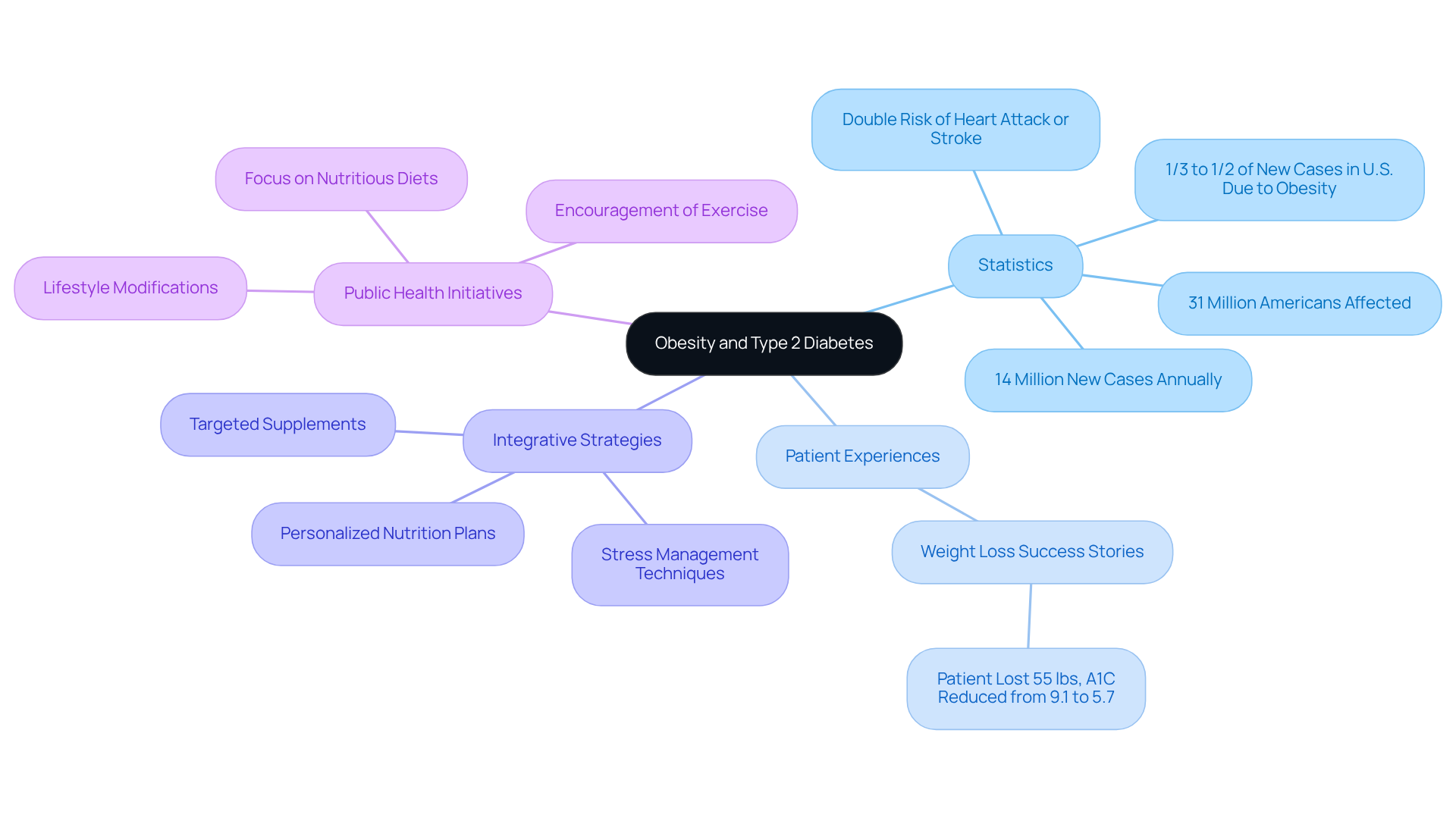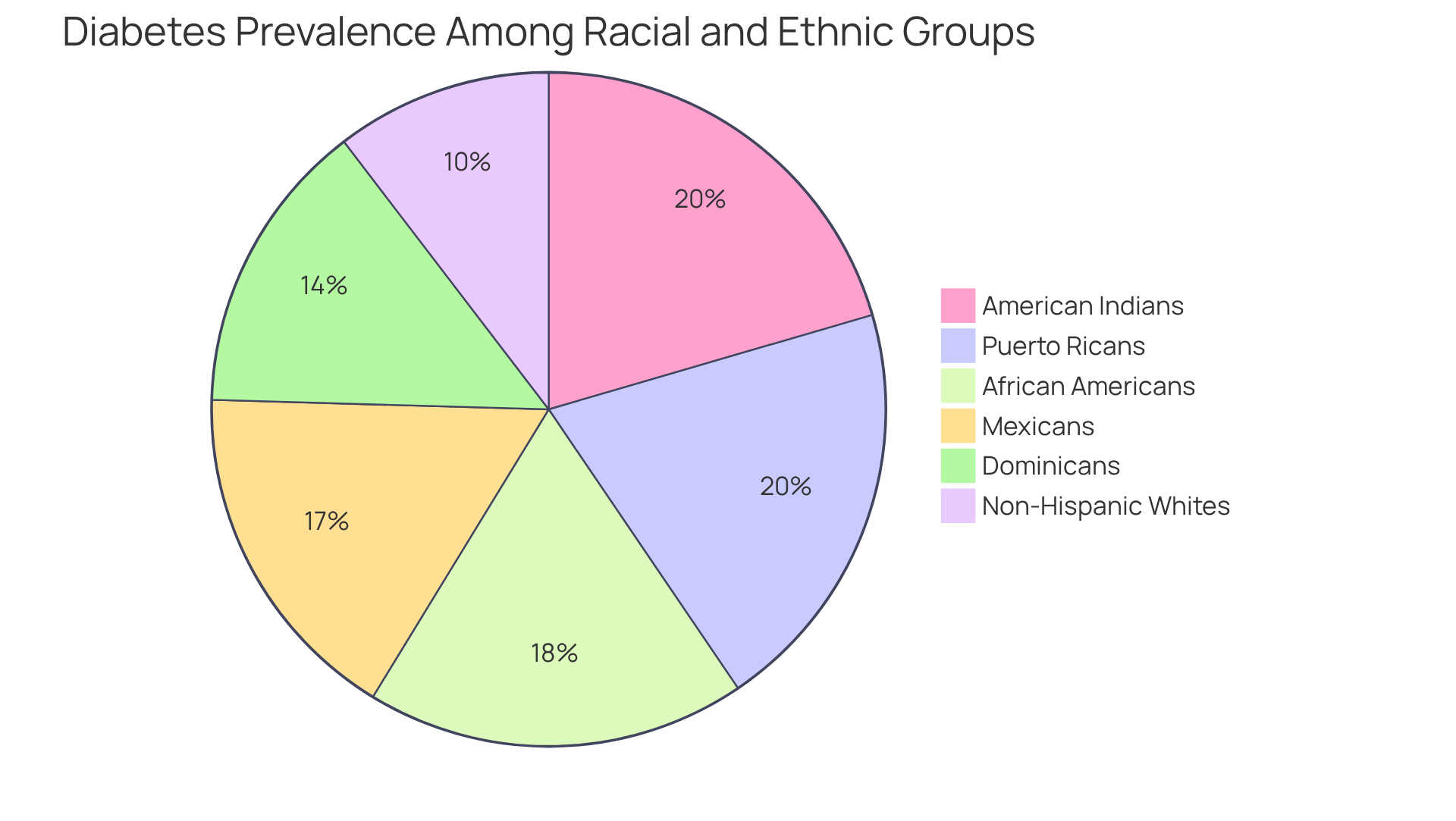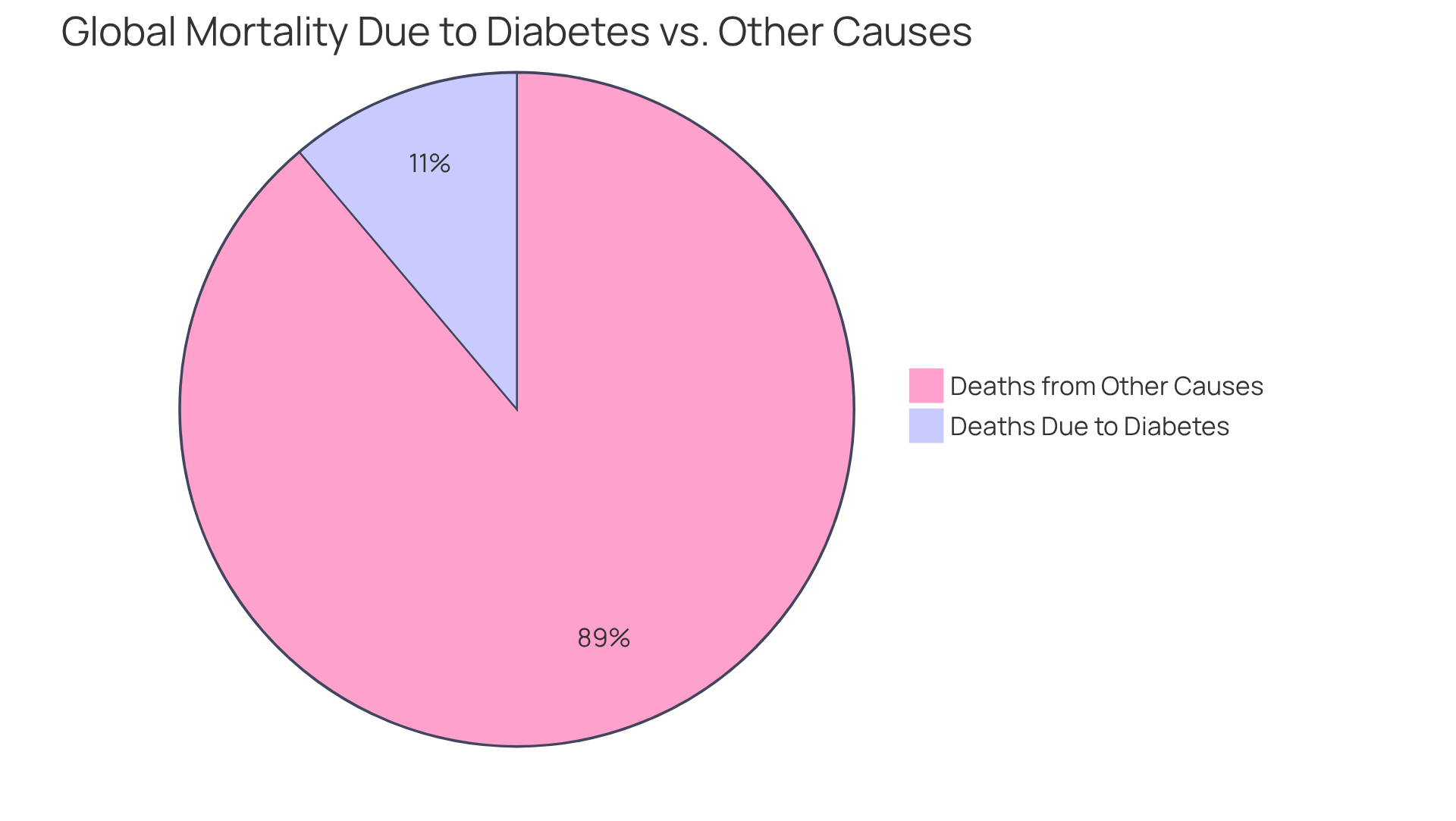Overview
It’s important to recognize the alarming reality of type 2 diabetes, with ten statistics that truly highlight its global prevalence. Did you know that by 2050, the number of individuals affected could soar to 1.3 billion? This is largely driven by rising obesity rates and sedentary lifestyles, which many of us can relate to in today’s fast-paced world.
This data serves as a wake-up call, underscoring the urgent need for effective prevention and management strategies. The increasing incidence of diabetes not only poses significant health risks but also places a substantial economic burden on healthcare systems worldwide.
Many patients find that understanding these challenges is the first step toward making positive changes. Together, we can address these concerns and work towards healthier lifestyles. Let’s take action, not just for ourselves, but for our communities as well.
Introduction
The rise of type 2 diabetes is a global health crisis that we must address together. Projections suggest that by 2050, an astonishing 1.3 billion people could be living with this condition. This growing epidemic is largely driven by obesity and sedentary lifestyles, which not only jeopardize individual health but also place a significant burden on healthcare systems around the world.
It’s important to recognize that these statistics reflect a troubling trend, and many individuals are feeling overwhelmed by this reality. So, how can we, as individuals and communities, combat this escalating threat and reclaim our health?
In this article, we will explore ten critical type 2 diabetes statistics that highlight the urgency of this issue and discuss transformative strategies for prevention and management. Together, we can make a difference.
Integrative Wellness Center: 30-Day Diabetes Reset Program for Lasting Health Transformation
Are you struggling with managing your diabetes? The Integrative Wellness Center’s 30-Day Diabetes Reset initiative is here to help you regain control of your health. This carefully designed program equips you with vital resources and understanding to improve your well-being. Imagine receiving individualized coaching, making dietary adjustments, and embracing lifestyle changes that target the underlying factors of type 2 health issues.
Throughout this journey, you’ll gain knowledge to make informed dietary decisions and enhance your physical activity, all within a supportive community that promotes lasting wellness transformations. It’s important to recognize that addressing both the physical and mental aspects of chronic illness care can cultivate lasting practices, leading to notable wellness advancements.
Many participants find that they experience life-changing outcomes, feeling empowered to take charge of their health. This comprehensive approach not only improves personal health but also reduces dependence on traditional medical treatments, showcasing the efficacy of functional medicine in managing blood sugar levels. Join us in this transformative experience, and take the first step toward a healthier, more vibrant life.
Global Diabetes Cases Expected to Reach 1.3 Billion by 2050
According to type 2 diabetes statistics worldwide from the International Diabetes Federation, the population living with type 2 conditions could reach a staggering 1.3 billion by 2050. This substantial rise highlights the pressing necessity to tackle increasing risk factors, especially obesity and inactive lifestyles, which are significant contributors to the epidemic of diabetes-related conditions.
Have you ever felt overwhelmed by these statistics? You’re not alone. In 2021, type 2 diabetes statistics worldwide indicated that type 2 accounted for 96% of cases, emphasizing the essential attention required on this category.
The type 2 diabetes statistics worldwide indicate that the prevalence of the disease is anticipated to increase, with areas such as North Africa and the Middle East already facing concerning rates, having the highest age-standardized rates at 9.3% in 2021, projected to rise to 16.8% by 2050.
It’s important to recognize that as type 2 diabetes statistics worldwide show this condition becoming more widespread, both individuals and healthcare systems must adopt effective prevention and control strategies to address this impending public welfare crisis.
Initiatives like Dr. Jason Shumard’s 30-Day Reset initiative at the Integrative Wellness Center offer hope. This program, integrating his postgraduate education in functional endocrinology and clinical nutrition, provides patients with the resources and understanding essential for effective management of their condition.
Many patients find that this program emphasizes holistic lifestyle strategies, empowering them to take control of their health amidst the alarming type 2 diabetes statistics worldwide. Together, we can navigate these challenges and work towards a healthier future.
Diabetes Prevalence Projected to Increase by 59.7% by 2025
Recent projections indicate that type 2 diabetes statistics worldwide are set to show a global prevalence rise of 59.7% from 2021 to 2025. This alarming increase is primarily driven by escalating obesity rates, linked to lifestyle changes such as poor dietary habits and decreased physical activity. It’s important to recognize that the type 2 diabetes statistics worldwide in 2021 indicated it represented more than 96% of all cases, highlighting the necessity for effective control strategies.
As the number of people diagnosed with diabetes continues to rise, it becomes essential for both healthcare providers and patients to adopt proactive measures. Many patients find that lifestyle modifications, including dietary adjustments and increased physical activity, play a crucial role in managing diabetes and can even reverse the condition in some cases.
Effective lifestyle change initiatives, like those provided by Dr. Jason Shumard’s center, equip patients with the information and resources needed to restore their well-being. By emphasizing education and tailored support, these initiatives cultivate an encouraging atmosphere that motivates individuals to take charge of their health and overall wellness.
If you are prepared to improve your health and control your condition effectively, reach out to us today to discover more about Dr. Shumard’s 30-Day Reset program. Together, we can embark on a journey toward a healthier, more fulfilling life.
Youth-Onset Type 2 Diabetes Cases Rising Sharply Worldwide
The occurrence of type 2 metabolic disorder among youth is escalating dramatically, and it’s important to recognize the profound impact this has on families and communities. Recent studies reveal a staggering 62% increase in new-onset diagnoses among children and adolescents following the COVID-19 pandemic. The SEARCH for Diabetes in Youth study identified over 5,293 cases of type 2 condition among individuals aged 10-19 years, highlighting a concerning trend that demands our immediate attention.
Many families find themselves grappling with this issue, as contributing factors include rising obesity levels, especially within minority groups. Black and Hispanic youth, in particular, have encountered higher rates of diabetes-related conditions. Sedentary lifestyles, exacerbated by increased screen time and reduced physical activity, further compound the problem. Additionally, poor dietary habits, characterized by high consumption of processed foods, play a critical role in this epidemic.
Experts emphasize the need for a multifaceted approach to combat this crisis. It’s essential to advocate for comprehensive education on healthy eating and the importance of regular physical activity. One effective strategy is to motivate young people to participate in organized walking activities. Starting with achievable objectives, like daily strolls of 10-15 minutes, can make a significant difference.
Selecting a safe and comfortable environment for walking is crucial, as is developing a consistent schedule and tracking progress to enhance motivation. Joining a walking group or partnering with a companion can also provide social support, making the activity more enjoyable. Community-focused initiatives that promote active living and nutritional education have shown promise in reversing these trends and enhancing well-being for youth at risk of diabetes.
Moreover, encouraging regular check-ups can enable early identification and action, ultimately empowering families to take proactive measures in managing their well-being. Together, we can foster a healthier future for our youth, and every small step counts.
Diabetes-Related Health Expenditures Projected to Exceed $1 Trillion Globally
Diabetes is projected to incur over $1 trillion in health expenditures globally by 2025. This staggering figure includes direct medical costs, such as hospitalizations and medications, along with indirect costs related to lost productivity and premature mortality. It’s important to recognize that the economic burden of this condition is further compounded by safety concerns in healthcare environments. For instance, there are approximately 7,000 incorrect medications given to patients and around 80,000 infections acquired in hospitals each year. These issues not only highlight the pressing need for effective prevention and management strategies but also emphasize the strain on our healthcare systems.
Many patients find that the financial impact on healthcare resources becomes increasingly critical as the type 2 diabetes statistics worldwide continue to rise. This situation necessitates innovative cost-reduction strategies to enhance patient care and outcomes. Charles “Chuck” Henderson, CEO of the American Diabetes Association, emphasizes that lowering the expense of this condition is crucial to improving the lives of all individuals affected. Furthermore, the WHO Global Diabetes Compact has outlined targets for enhancing care for those with diabetes by 2030, showcasing global efforts to address this pressing issue. Together, we can work toward a healthier future for everyone impacted by this condition.
Over 50% of Diabetes Cases Remain Undiagnosed Globally
Worldwide, it is estimated that over 50% of people living with this condition remain unaware of their health status. This lack of awareness can significantly delay diagnosis and treatment, leading to severe medical complications. Have you considered how this could heighten your risks for cardiovascular disease, kidney failure, and other serious health issues? These complications not only affect your well-being but also drive up healthcare expenses. In fact, this condition has led to at least USD 1 trillion in health expenditure, placing a substantial financial burden on healthcare systems.
It’s important to recognize that regular screenings are vital in addressing this alarming trend. They can facilitate early detection and intervention, which is crucial for better health outcomes. Health organizations stress the importance of awareness campaigns to educate the public about risk factors and symptoms, encouraging individuals to seek medical advice promptly. Many patients find that understanding their condition empowers them to take control of their health.
Moreover, it’s essential to comprehend that traditional treatments for blood sugar issues, like insulin injections, can occasionally worsen insulin resistance, complicating control efforts. By cultivating an environment of proactive wellness oversight, including recognizing the risks linked to traditional therapies and adopting comprehensive lifestyle approaches, we can reduce the effects of undiagnosed conditions on overall wellness results.
In San Marcos, CA, for example, individuals can benefit from community support, nutrition-oriented initiatives, and tailored advice from healthcare experts like Dr. Jason Shumard. These resources are crucial for effectively managing the condition. Taking action today by scheduling regular screenings and seeking holistic care can lead to better health outcomes. Remember, you are not alone in this journey; support is available, and proactive steps can make a significant difference.
Obesity Linked to 14 Million New Cases of Type 2 Diabetes Annually
According to type 2 diabetes statistics worldwide, obesity is a significant risk factor for type 2 diabetes, contributing to approximately 14 million new cases each year. Alarmingly, one-third to one-half of these new cases in the U.S. are attributed to obesity. It’s important to recognize that the rising rates of obesity, particularly among children and adolescents, are concerning and necessitate immediate action.
Many patients find that integrative functional medicine strategies, such as:
- Personalized nutrition plans
- Stress management techniques
- Targeted supplements
play a crucial role in reversing this trend. As emphasized by transformative patient experiences, individuals who embrace a holistic perspective on their well-being can attain remarkable outcomes. For instance, one patient shared, “I lost 55 lbs. My A1C started at 9.1 after 8 months it is now 5.7,” showcasing the effectiveness of tailored interventions.
Moreover, social determinants of wellness also play a crucial role in these disparities, underscoring the need for targeted interventions. Public health initiatives concentrating on nutritious diets, exercise, and lifestyle modifications are crucial to counter this trend and lower the occurrence reflected in type 2 diabetes statistics worldwide. As Dr. Natalie Cameron highlights, reducing obesity should be a priority, indicating that initiatives encouraging healthy lifestyles could greatly diminish new cases of Type 2.
It’s essential to understand that every step toward a healthier lifestyle counts. Engaging in supportive communities and utilizing available resources can make a significant difference. Remember, you are not alone in this journey, and there are paths to a healthier future.
Diabetes Prevalence Varies Significantly by Race and Ethnicity
Diabetes prevalence varies significantly across racial and ethnic groups, and it’s essential to recognize that certain populations face disproportionately higher rates of this disease. For example:
- 13.6% of American Indians are affected
- 12.1% of African Americans are affected
- 6.9% of non-Hispanic White adults are affected
Among Hispanic adults, the prevalence is notably high as well, with:
- Puerto Ricans at 13.3%
- Mexicans at 11.1%
- Dominicans at 9.4%
These disparities highlight a critical need for focused public health programs that not only address the medical aspects of diabetes but also consider cultural factors. Many patients find that resources tailored to their unique needs can make a significant difference in managing their health. Effective interventions have shown that culturally aware approaches can greatly improve diabetes control and outcomes among minority groups.
Ultimately, by fostering understanding and support, we can work together to alleviate the impact of this chronic illness. It’s important to remember that you’re not alone in this journey; there are resources and communities ready to help you take charge of your health.
Diabetes Contributes to Over 1.5 Million Deaths Each Year
According to type 2 diabetes statistics worldwide, diabetes claims 6.7 million lives each year, translating to a heartbreaking loss every five seconds. This makes it one of the leading causes of mortality according to type 2 diabetes statistics worldwide. The complications associated with diabetes—like cardiovascular disease, kidney failure, nerve damage, and vision loss—play a significant role in this alarming statistic. It’s important to recognize that efficient oversight and preventive measures are crucial to reducing the mortality rate linked to this condition and improving overall community health. As Dr. Jason Shumard emphasizes, addressing the underlying causes of diabetes is essential for effective treatment.
Many patients find that effective glucose control initiatives, such as the comprehensive 30-Day Reset program, are vital in decreasing these complications. They have reported transformative experiences, including significant weight loss, enhanced energy levels, and a reduced need for medications. One patient shared, “I lost 55 lbs. My A1C started at 9.1 after 8 months; it is now 5.7.” Another noted, “I feel so much better… I lost a lot of weight, have more energy, and feel great. I am not depressed anymore and I don’t need my meds anymore!” By equipping patients with the essential resources and understanding to manage their well-being effectively, these initiatives not only improve individual outcomes but also contribute to broader public health advancements.
The focus on early diagnosis and proactive management is crucial in tackling the rising mortality rates associated with type 2 diabetes statistics worldwide. This underscores the urgent need for effective prevention strategies and patient education. If you’re ready to take charge of your health and combat the effects of type 2 diabetes, reach out to Dr. Shumard today to learn more about the 30-Day Reset program.
Sedentary Lifestyle Linked to Increased Risk of Type 2 Diabetes
Living a sedentary lifestyle can significantly increase the risk of developing type 2 conditions. It’s concerning to realize that many of us spend long hours sitting, with studies indicating that this leads to insulin resistance and weight gain. In fact, nearly 1 in 4 Americans sit for 8 hours or more each day, a trend that correlates with rising blood sugar-related issues.
It’s important to recognize that combating this risk is possible through regular physical activity. Engaging in activities like walking, cycling, or strength training is essential for our health. The World Health Organization recommends that adults aim for at least 150 minutes of moderate or 75 minutes of vigorous physical activity each week. A structured walking plan can be a wonderful starting point.
Many people find it helpful to begin by evaluating their current fitness level and setting realistic goals. For instance, committing to a daily walk of just 10-15 minutes can make a difference. Choosing a safe and comfortable environment, whether indoors or outdoors, is crucial for your success. Developing a consistent schedule and gradually increasing the duration and frequency of your walks can significantly enhance your overall wellness and vitality.
Tracking your progress using a journal or an app can keep you motivated and help you celebrate your achievements along the way. Have you considered joining a local hiking group or participating in organized walking initiatives? Community support can enhance accountability and make the experience more enjoyable. Public health programs are increasingly focusing on promoting active lifestyles and reducing sedentary habits. They recognize that making physical activity accessible and enjoyable can greatly lower the risk of noncommunicable diseases, including chronic conditions.
Successful programs have shown that community engagement and education can inspire individuals to incorporate more movement into their daily routines, ultimately fostering healthier populations. As WHO Director-General Dr. Tedros Adhanom Ghebreyesus wisely noted, ‘We have seen an alarming rise in type 2 diabetes statistics worldwide over the past three decades, reflecting the increase in obesity, compounded by the impacts of the marketing of unhealthy food, a lack of physical activity, and economic hardship.’ Let’s take these insights to heart and work together toward a healthier future.
Conclusion
The alarming statistics surrounding type 2 diabetes highlight a pressing global health crisis that requires our immediate attention. Can you imagine a future where 1.3 billion individuals are living with this condition by 2050? This stark projection underscores the urgent need for collective action to combat this epidemic. Integrating lifestyle changes, community support, and targeted health initiatives is essential for reversing these trends and improving health outcomes.
Throughout this article, we’ve uncovered key insights that reveal the multifaceted nature of the diabetes crisis. The staggering rise in youth-onset cases and the financial burden exceeding $1 trillion annually paint a grim picture of the future if we do not take proactive measures. Moreover, the disparities in diabetes prevalence across racial and ethnic groups emphasize the necessity for culturally sensitive public health programs. Programs like the Integrative Wellness Center’s 30-Day Diabetes Reset are vital resources, empowering individuals to reclaim their health through education, support, and holistic lifestyle changes.
Addressing the type 2 diabetes epidemic calls for a united effort from individuals, healthcare providers, and communities. By prioritizing awareness, education, and preventive measures, we can significantly reduce the impact of this condition on future generations. It’s important to recognize that every action counts in this collective journey toward better health and well-being. Taking proactive steps today—whether through lifestyle modifications, regular screenings, or participation in community wellness programs—can foster a healthier future for all. Together, let’s embrace this opportunity for change and support one another on the path to wellness.
Frequently Asked Questions
What is the 30-Day Diabetes Reset Program at the Integrative Wellness Center?
The 30-Day Diabetes Reset Program is an initiative designed to help individuals manage their diabetes through individualized coaching, dietary adjustments, and lifestyle changes that address the underlying factors of type 2 health issues.
What can participants expect to gain from the program?
Participants can expect to gain knowledge for making informed dietary decisions, enhance their physical activity, and benefit from a supportive community that fosters lasting wellness transformations.
How does the program address both physical and mental aspects of chronic illness?
The program recognizes the importance of addressing both physical and mental aspects of chronic illness care, which can lead to lasting practices and notable wellness advancements.
What are the statistics regarding type 2 diabetes prevalence?
According to the International Diabetes Federation, the population living with type 2 diabetes could reach 1.3 billion by 2050, with type 2 diabetes accounting for 96% of cases in 2021.
What factors contribute to the rising cases of type 2 diabetes?
Significant contributors to the rise in type 2 diabetes cases include obesity and inactive lifestyles, which are pressing risk factors that need to be addressed.
What is the projected increase in diabetes prevalence by 2025?
The global prevalence of type 2 diabetes is projected to increase by 59.7% from 2021 to 2025, primarily driven by rising obesity rates and poor lifestyle choices.
How does the 30-Day Reset Program help manage diabetes?
The program emphasizes holistic lifestyle strategies, including dietary adjustments and increased physical activity, empowering participants to take control of their health and manage their condition effectively.
Who leads the 30-Day Diabetes Reset Program?
The program is led by Dr. Jason Shumard, who integrates his postgraduate education in functional endocrinology and clinical nutrition to provide patients with essential resources for managing their diabetes.
